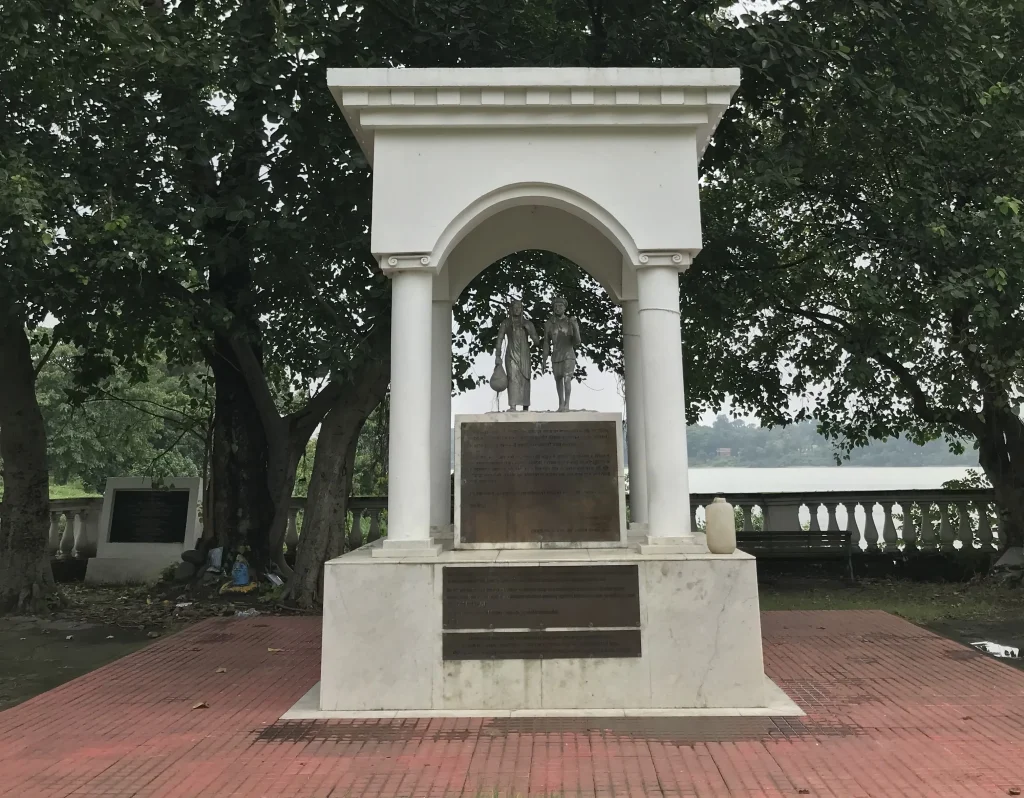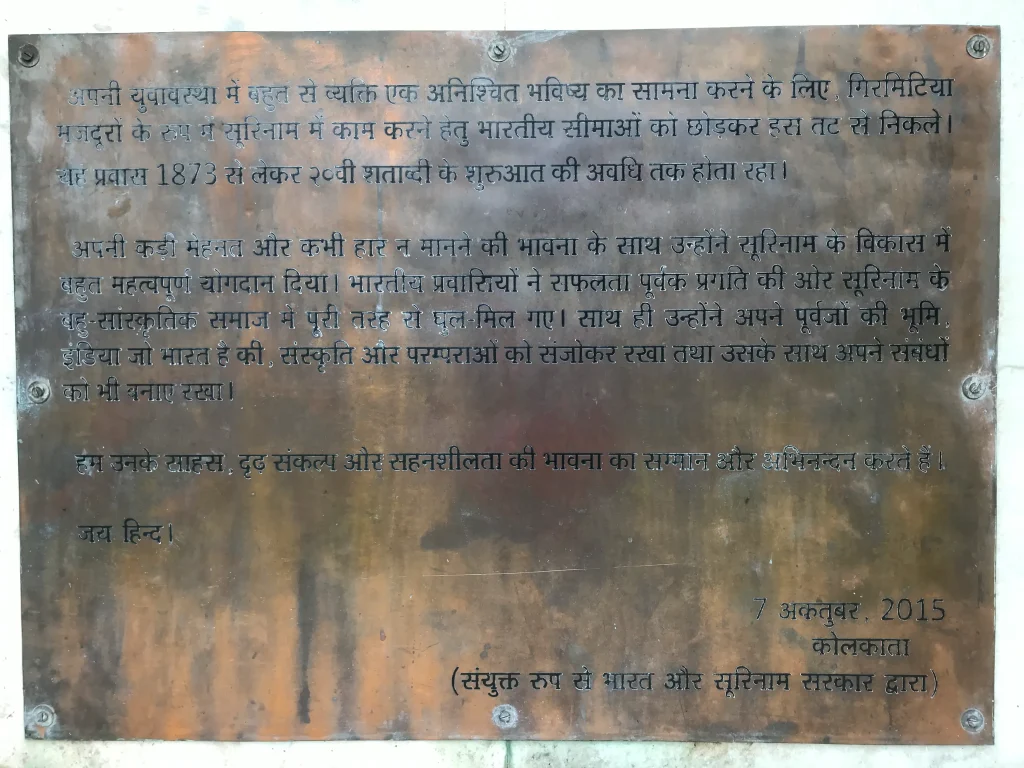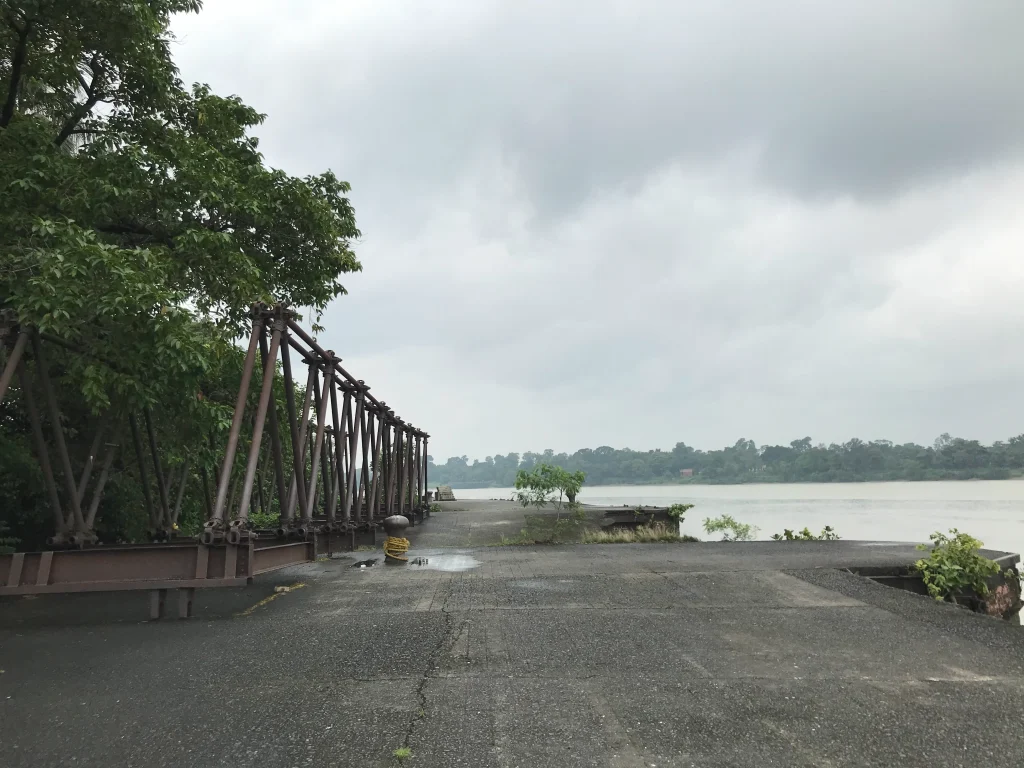On the Trails of Indenture
by Mukulika Batabyal
An account of the trials and travails of indentured labourers migrating from British India to Suriname and Guiana in the nineteenth century, revealing a colonial history of exploitation and the changing dynamics of caste, gender and religion in the relevant diaspora communities.

The Baba-Mai Monument at Suriname Ghat, Kolkata, 2023.
Courtesy of Sudeshna Rana
The Suriname Ghat in Kolkata is located along the banks of the Hooghly River. It gets its name from the long historical struggle of the indentured labourers from India, who were shipped off to Suriname in South America following an agreement between the Dutch and the British governments, to work in the Dutch plantations of Suriname. On 26th February, 1873, Lalla Rookh, a ship carrying 410 passengers—all recruited as labourers—set sail from the now Suriname Ghat, and after a three-month voyage reached Paramaribo, the capital of Suriname. Nearly all the passengers were from Uttar Pradesh and Bihar. Only 399 out of the 410 made it through the voyage; 11 passengers lost their lives during the journey. Over the following decades, 63 more ships made the same journey using that very Ghat.
It was only in 2015, nearly a century after the last ship carrying the indentured labourers had left the port in 1917, that a memorial was unveiled to commemorate this incredibly significant yet lesser-known event, of the colonial history of exploitation. The “Mai-Baap” (meaning “Mother-Father”) statue featuring a plainly dressed man and a woman carrying a small cloth bag walking along the port, symbolises the journey of hundreds of indentured labourers—whose lives were held by agreements—packing a life and leaving behind every known thing for a fate unknown. The statue was built to honour the struggles and hardships they had faced in the hope of a better life. This monument is a counterpart of the original “Baba and Mai” (meaning “Father-Mother”) monument in Paramaribo, which symbolises the arrival of the first indentured labourers to Suriname.
After the abolition of slavery in the mid-1800s, a crisis of labour arose for the imperialists, the solution to which was brought forth by the indenture system. The indenture system was a method of recruiting contractual labourers to serve at the various sectors that were facing a lack of labourers. These workers were generally hired from the colonies to serve as migrant labourers for a specified period of time during which they were grossly underpaid by their employers. However, most workers were not set free after the end of the contract, and this new form of recruitment became a mask for legitimised slavery. These labourers came to be called ‘jahajis’, from the Hindi word ‘jahaj’ meaning ship, to indicate the people who were shipped off in vessels to serve at the behest of their recruiters—the colonisers in these plantations. Since the indenture system relied on the contracts or agreements drafted and signed by the British, specifying the duration and conditions of labour, upon which the lives of these hundreds of migrant workers depended, they were also called girmitiyas, from the English word “agreement”—a term that encapsulated their helplessness and lack of control in setting the terms of their own lives. These immigrants ultimately went on to shape much of the Surinamese culture, introducing and integrating cultural and religious changes that live on even today.

Commemorative plaque at Suriname Ghat, Kolkata, 2023.
Courtesy of Sudeshna Rana
This history of indenture, although so integral to the understanding of several Indian diasporas across the globe, remains comparatively less explored. While indentured labourers from both genders were hired, the women were largely outnumbered by men. Because there were so few immigrant indentured women, they would partner across caste, with men who offered more financial security in an extremely exploitative environment.
Gaiutra Bahadur’s book Coolie Woman: The Odyssey of Indenture is one of the rare accounts of women’s history in British Guiana, another colony near Suriname, across the Corentyne River. The book traces the journey of her great grandmother, Sujaria, who left her home in 1903, while four months pregnant. Most existing records of indentured women discovered by Bahadur were those involved in scandals or tragedies.
In one of the most haunting chapters in the book, “Beautiful Woman Without a Nose,” Bahadur poetically describes the ritual of singing the tales of Tulsidas’s Ramcharitmanas after a hard day of labour at the fields, outside their barracks by torchlight. This epic poem’s episodes were enacted through Ramleela traditions in the form of lavish carnivals to facilitate a social life among the immigrants. These stories’ preoccupation with women’s sexual behaviour and adultery only heightened its relevance in the lives of the diaspora. Bahadur refers to the story of Surpanakha, who was mutilated and disfigured as a punishment for her “sexual transgressions”, and finds the tale’s relevance connected to the woes faced by indentured women.

A view of the Hooghly River and the jetty at the Suriname Ghat, Kolkata, 2023.
Courtesy of Sudeshna Rana
“Between 1859 and the indenture’s end in 1917, more than 167 women were killed by intimate or would-be intimate partners in Guiana. Infidelity—or, the fear of it—motivated the crime in most cases, colonial authorities claimed,” wrote Bahadur. Men used the cutlass, an agricultural tool to perpetuate violence on women, mostly citing sexual jealousy as the reason. According to a study commissioned by the British Colonial Office in 1871, Indian men were killing their romantic partners “at a rate 142 times greater in Guina than in India’s Northwestern Provinces and Oudh.” In Fiji, another British colony, such cases were so common that there was an appeal by a group of Indians for ending the death penalty stating the perpetrators were otherwise law-abiding.
The cutting off of a woman’s nose became a brand of infidelity in the colonies across the dark water. The violence and the murders fitted into the trope of “white men saving brown women,” evoking the empire’s civilising project on its racialised colonial subjects. The stories of indentured women reveal a complicated past—one where they bore the brunt of both the horrors of the colonial system and the atrocities of gender-based violence.
References:
Also read: Reclamation
About the author
Mukulika Batabyal is an Assistant Professor of English at Shaheed Rajguru College (Delhi University). She holds an MPhil in English from the University of Delhi. Her research interests include film studies, cultural studies, postmodernism, psychoanalysis, and gender studies. She has written reviews for various international film festivals, some of which have been considered as external reviews for IMDb. She is also a poet and writer whose debut collection of poems, Longings, was published by Hawakal as part of their Young Poets’ Project in 2022. Her poems have also been included in various other anthologies and international journals, including Dreich Scotland, Gideon Poetry Review, etc.
She is on Instagram: @moodlekoodlepoodle
